Holly Trees and Bushes: Types, Leaves, Flower, Berries (Pictures) – Identification Guide
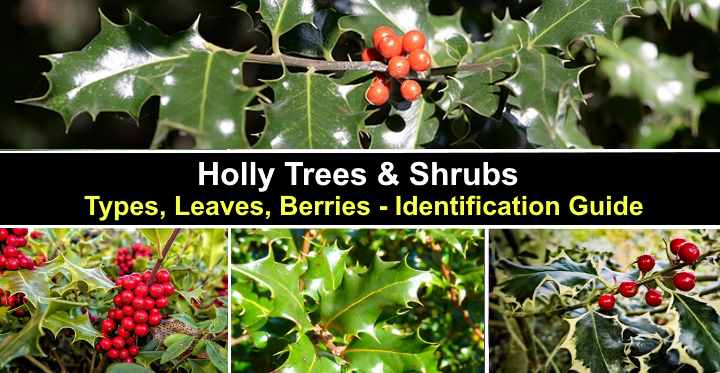
Holly trees and bushes are large shrubs or trees, many of which have thick, glossy, spiky leaves, small white flowers, and yellow, orange, black, or red berries. Although most species of hollies are evergreen plants, there are some deciduous holly bushes that drop their leaves in winter. The most common holly species are the American holly (Ilex opaca) and the English holly (Ilex aquifolium). Both of these evergreen holly trees are famous for their shiny, jagged leaves and winter red berries.
There are around 480 species of holly plants that grow in subtropical or temperate regions of the world. Holly plants can be evergreen or deciduous. The various types of hollies include large trees, bushy shrubs, and dwarf cultivars. Holly shrubs also make ideal security hedges due to their sharp, spiked leaves and dense foliage.
The berries on holly trees are mildly toxic to humans. Although wildlife can consume holly berries, the tiny colorful fruits can cause stomach upset, diarrhea, vomiting, and drowsiness if humans eat them. Because holly berries are poisonous, it’s best not to plant holly bushes where children play.
This article is a guide to the best types of holly trees and bushes for growing in your garden. Descriptions and pictures of holly plants will help you decide on the best type of holly for an evergreen landscape.
Types of Holly Plants
Holly plants belong to the genus Ilex and the family Aquifoliaceae. Hollies are classed as dioecious plants, meaning that male and female flowers grow on different plants. Holly trees can grow between 30 and 80 ft. (10 – 24 m) tall. However, holly bushes typically grow up to 6 ft. (1.8 m) tall and are multi-stemmed plants.
Evergreen Holly Plants
Most plants in the holly family are evergreen shrubs or trees. The evergreen holly plants are generally recognizable by their thick, glossy leaves with sharp spines along the margins. The thorny evergreen shrubs also add color to drab winter landscapes with their clusters of colorful berries and shiny foliage.
Deciduous Holly Plants
The most common deciduous holly plant is the native winterberry shrub. The slow-growing deciduous holly shrub leaves may turn maroon in the fall before the leaves drop. Then abundant bright red berries growing on bare stems add plenty of color throughout the winter until the following spring when the green leaves start to grow back.
Dwarf Holly Shrubs
Dwarf holly shrubs are ideal plants for compact gardens, evergreen hedgerows, or growing in containers. The dwarf shrubs have all the recognizable features of the larger bushes and trees. In addition, spiky, evergreen foliage and clusters of red berries make dwarf holly shrubs popular for winter gardens.
Holly Leaves
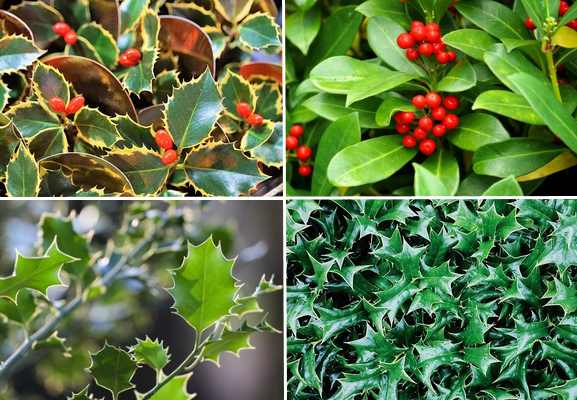
Holly leaves can be spiked or smooth, green or variegated
Holly leaves are typically ovate or oblong, glossy green with wavy margins that are spiked, serrated, or smooth. Looking at holly tree or holly bush leaves is one of the best ways to identify individual Ilex species. For example, leaves on English holly and American holly are ovate with sharp spines on the wavy margins.
Holly plants with leaves that have few or no spines include the inkberry holly tree (Ilex glabra), American spineless holly (Ilex opaca), Japanese holly (Ilex crenata), and deciduous American winterberry holly bush (Ilex verticillata).
Some of the most spectacular varieties of holly trees and bushes are variegated cultivars. Most types of variegated holly plants have glossy dark to light green leaves with creamy yellow margins. In addition, there are variegated holly shrubs with spiky leaves or leaves with smooth margins.
Holly Flower
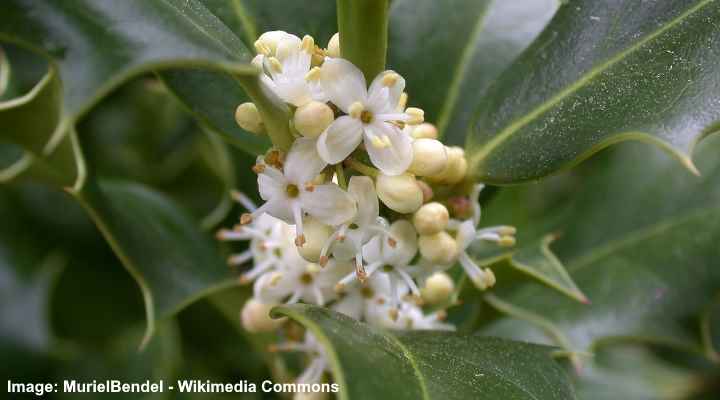
Holly flowers
Holly flowers are inconspicuous greenish-white flowers made up of four petals. The plant’s flowers can help identify female holly plants apart from male flowers. Looking up close, pictures of male holly plant flowers show they have longer stamens than female holly flowers.
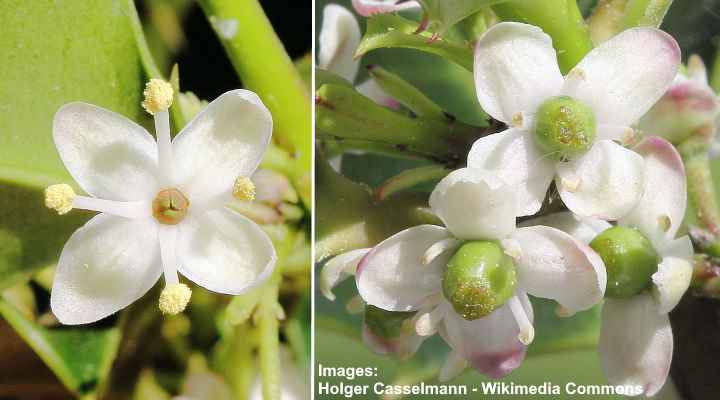
Male ilex aquifolium flower (left) and female flowers (right). The female flowers produce berries
Holly Berries
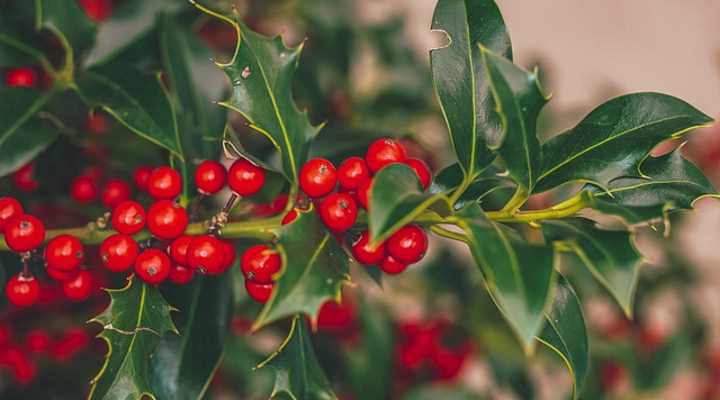
The inedible berry-like fruits of holly are usually red but can be other colors
Holly berries are one of the most recognizable features of plants in the Ilex genus. Botanically speaking, the fruit on holly plants are tiny round drupes, not berries. However, most people refer to holly fruit as berries.
Holly berries appear in the fall and ripen in winter. The inedible berries are typically shades of red, orange, black, or brown. In rare cases, species of holly plants produce green or yellow berries. Holly berries usually stay on the evergreen bushes throughout the winter.
It is not safe to eat the red berries from a holly shrub or tree. According to scientists, holly berries—especially from Ilex aquifolium (English holly) and Ilex opaca (American holly)—contain toxins that can cause nausea, vomiting, stomach cramps, and dermatitis. However, poisoning from holly berries is usually harmless.
Holly Identification
The best way to identify holly trees and bushes is by looking at the leaves and berries. Individual species of hollies have distinctive glossy leaves with wavy margins and jaggy spines, small blunt points, or smooth edges. Also, species of female holly trees are identifiable by the berries they produce because male hollies don’t grow berries.
Types of Holly Trees (With Pictures)
Let’s look in more detail at common varieties of holly trees suitable for evergreen winter landscapes.
American Holly Tree (Ilex opaca)
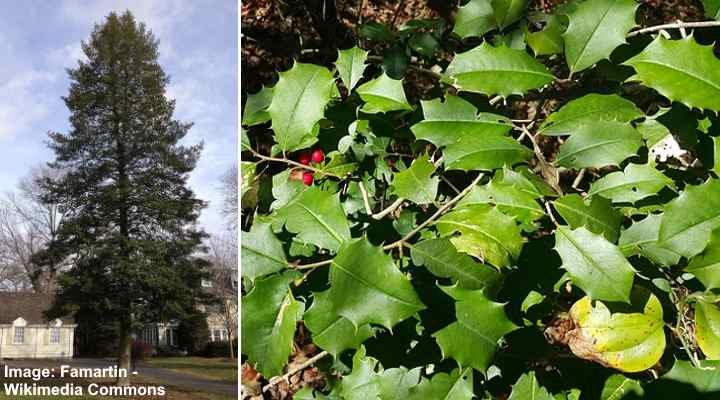
American holly tree (Ilex opaca)
The American holly is a tall tree with dull, dark green leathery leaves with spiny margins and orange to red berries appearing in the fall. The American holly tree looks like the English holly and is often used for Christmas decorations. The tall holly tree has an open, pyramidal shape.
Evergreen American holly trees are also called the Christmas holly.
Sun exposure: Deep shade to full sun
Size: 40 to 60 ft. (12 – 18 m) high and up to 20 ft. (6 m) wide
USDA zones: 5 to 9
Holly tree leaves: American holly tree leaves are dull green and prickly that measure up to 4” (10 cm) long and 3” (7.5 cm) wide.
Holly tree berries: American holly tree berries are shades of orange to red and grow among the evergreen foliage from September until February.
Yaupon Holly (Ilex vomitoria)
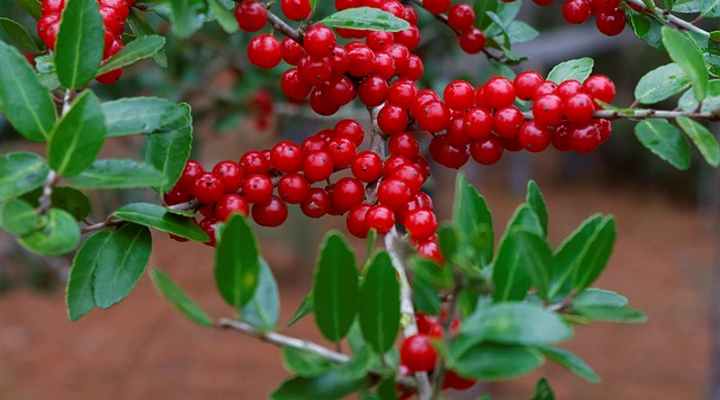
Yaupon holly (Ilex vomitoria)
The yaupon holly is a small evergreen tree or large shrub with small glossy, dark green leaves, clusters of whitish flowers, and shiny red berries. The identifying feature of the yaupon holly is its small, rounded leaves that don’t have an apex. The dense, evergreen foliage makes this holly plant ideal for a hedge, windbreak, or screen.
The yaupon holly tree is a multi-stemmed shrub-like holly tree with its dense foliage ideal for growing as a dense hedge.
A dwarf variety of yaupon holly is the ‘Nana’ cultivar which has compact, rounded growth. The dense evergreen shrub grows up to 5 ft. (1.5 m) tall and 6 ft. (1.8 m) spread and is a popular landscape plant that can be used for topiary.
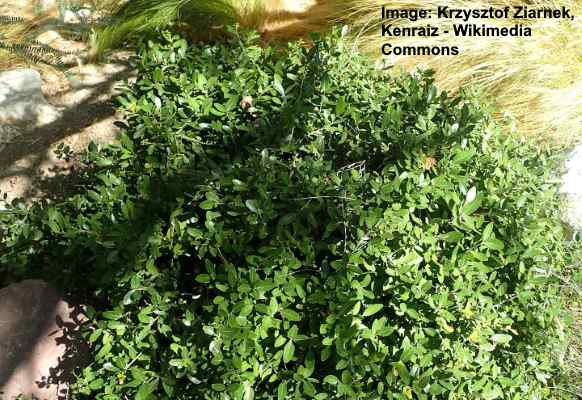
Ilex vomitoria ‘Nana’
Sun exposure: Full sun to part shade
Size: 10 to 20 ft. (3 – 6 m)
USDA zones: 7 to 9
Holly tree leaves: Yaupon holly tree leaves are rounded and small, only measuring 1” (2.5 cm) long and 0.5” (1.2 cm) wide.
Holly tree berries: Yaupon holly tree berries are showy burgundy or red drupes that grow in large clusters.
Dahoon Holly Tree (Ilex cassine)
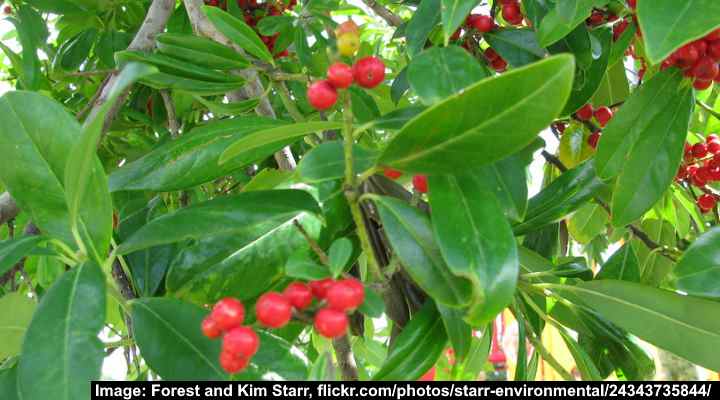
Dahoon holly tree (Ilex cassine)
The dahoon holly is a small evergreen tree with ovate to oval smooth green leaves with slightly serrated tips and brilliant red winter berries. Unlike common varieties of holly trees, the dahoon holly doesn’t have spiky leaves. The holly is identifiable by its yellowish-white fragrant spring flower clusters.
The dahoon holly is a slow-growing holly tree.
Sun exposure: Partial shade or full sun
Size: 20 to 30 ft. (3 – 9 m) tall and up to 15 ft. (4.5 m) wide
USDA zones: 7 to 11
Holly tree leaves: The dahoon holly tree leaves are elongated obovate-shaped with a pointed end at the base and serration at the rounded tips.
Holly tree berries: The dahoon holly tree berries are a red-orange color and grow in characteristic clusters.
Chinese Holly (Ilex cornuta)
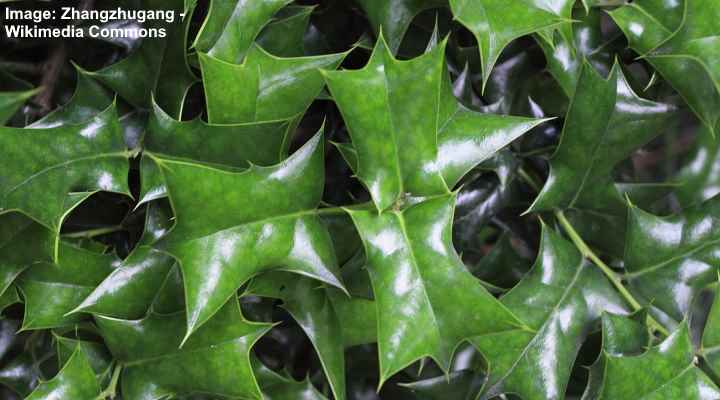
Chinese holly (Ilex cornuta)
The Chinese holly is native to Asia and has long, glossy green, prickly leaves, dark red berry-like fruits, and white flowers with four tiny petals. The identifiable feature of Chinese holly trees is their unusual rectangular leaves with two to four spikes that look like bull horns. In addition, the small Chinese holly tree has a rounded, vase-shaped crown.
The Chinese holly tree is classified as a small tree or large shrub. Its dense, spiky foliage means this holly tree is ideal as an impenetrable hedge, living fence, or privacy barrier.
Sun exposure: Full sun to partial shade
Size: 8 to 15 ft. (2.4 – 4.5 m)
USDA zones: 7 to 9
Holly tree leaves: Chinese holly tree leaves are dark green, shiny leaves in a rectangular shape with two or more spines.
Holly tree berries: Chinese holly tree berries are red and grow in clusters between glossy foliage.
Oak Leaf Holly (Ilex x ‘Conaf’)
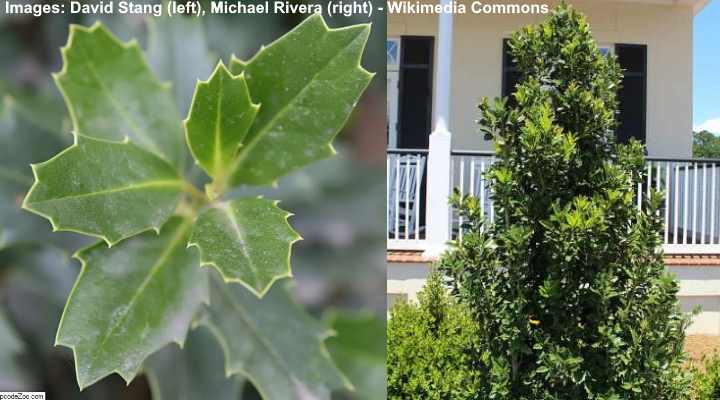
Oak leaf holly (Ilex x ‘Conaf’)
The oakleaf holly is a small tree with glossy green leaves that look like spiky oak tree leaves. Apart from its prickly, lanceolate leaves, the identifying feature of the oakleaf holly tree is its orangey-red berries that stay on the evergreen tree throughout winter.
The oak leaf holly tree has an upright, pyramidal shape. Grow the oak leaf holly plant as foundation plantings, an evergreen border, or privacy hedge.
Sun exposure: Full sun or light shade
Size: 15 to 20 ft. (4.5 – 6 m) tall and up to 15 ft. (4.5 m) wide
USDA zones: 6 to 9
Holly tree leaves: Oak leaf holly tree leaves are 3.5” (9 cm) long and are leathery, green ovate leaves with spiny margins. New leaves emerge from bronze to burgundy.
Holly tree berries: Oak leaf holly tree berries are various shades of orange or red.
English Holly (Ilex aquifolium)
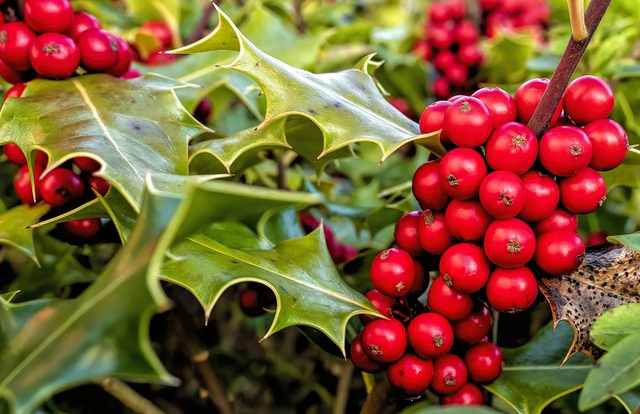
English holly (Ilex aquifolium)
The popular English holly tree is famous for its dark glossy green prickly leaves, clusters of bright red berries, and winter decorations. The English holly is usually used for Christmas decorations in Europe. To ensure you get bright red berries, you need to plant a male and female holly tree.
The botanical name for the English holly means needle leaf. It describes the sharp thorny leaves, making this bush ideal as a security hedge.
Sun exposure: Full sun or partial shade
Size: 30 to 50 ft. (9 – 15 m) tall and 15 to 25 ft. (4.5 – 7.6 m) wide
USDA zones: 5 to 9
Holly tree leaves: English holly tree leaves are glossy green wavy leaves measuring up to 3” (7.5 cm) long in an elliptical shape with spiked margins.
Holly tree berries: English holly tree berries are yellow, orange, burgundy, or red.
Eagleston Holly (Ilex x ‘Eagleston’)
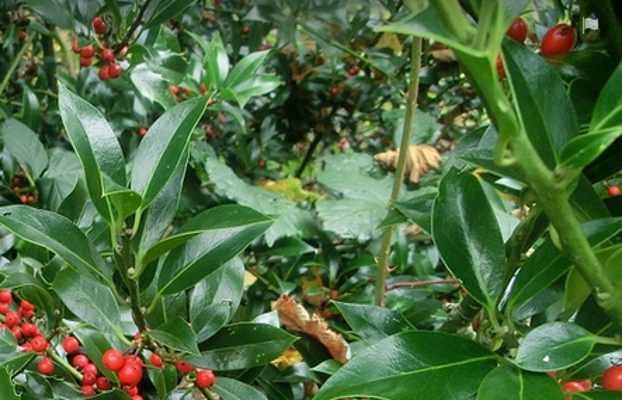
Eagleston holly (Ilex x ‘Eagleston’)
The Eagleston holly tree is a hybrid of the American holly and dahoon holly. The small tree has shiny green leaves with soft spines and red winter berries. The Eagleston holly has a pyramidal crown with evergreen foliage that looks attractive all year long.
Sun exposure: Full sun or partial shade
Size: 20 ft. (6 m) tall and 14 ft. (4.2 m) wide
USDA zones: 6 to 9
Holly tree leaves: Eagleston holly tree leaves are green ovate leaves and sometimes have tiny short yellowish spines along the margins.
Holly tree berries: Eagleston holly tree berries are bright red and persist throughout the winter.
Japanese Holly (Ilex crenata)

Japanese holly (Ilex crenata)
The Japanese holly is a small tree or large shrub with a rounded crown and small round leaves like boxwood and black berry-like drupes. The evergreen Japanese holly tree is one of the hardiest holly trees and is relatively resistant to disease. Grow it for foundation plantings, evergreen hedges, or a specimen tree.
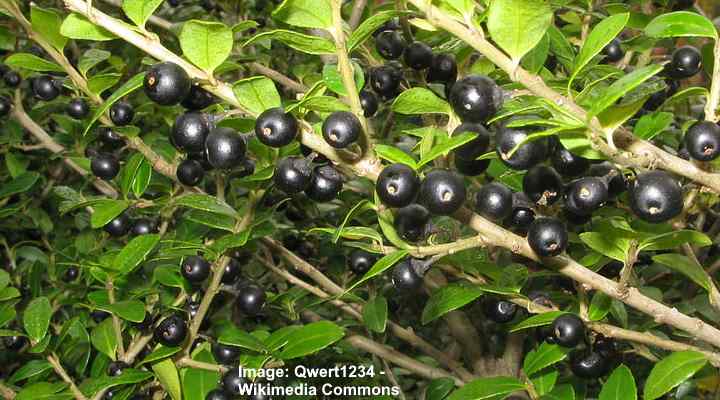
Ilex crenata berries are black
Sun exposure: Full sun to partial shade
Size: 4 to 10 ft. (1.2 – 3 m) tall and wide
USDA zones: 5 to 7
Holly tree leaves: Japanese holly tree leaves are small and oval, like plant leaves from the Buxus genus.
Holly tree berries: Japanese holly tree berries are large, black, rounded fruits that look like large blackcurrants.
Sky Pencil Holly (Ilex crenata ‘Sky Pencil’)
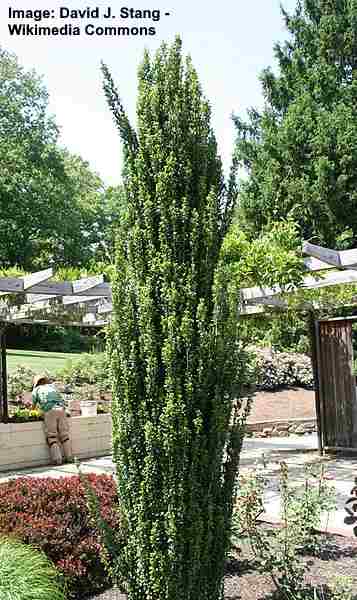
Sky Pencil holly (Ilex crenata ‘Sky Pencil’)
The sky pencil holly plant is a tall, skinny tree or tall, narrow holly bush with small oval leaves like boxwood plants. The identifying features of the sky pencil holly are its narrow growth, small leaves, and showy black fruit. Growing a sky pencil holly tree is ideal for adding an evergreen vertical accent to a garden landscape.
Sun exposure: Full sun to partial shade
Size: 4 to 10 ft. (1.2 – 3 m) tall and 1 to 3 ft. (0.3 – 1 m) wide
USDA zones: 5 to 8
Holly tree leaves: Glossy green oval leaves that are 1” (2.5 cm) long.
Holly tree berries: Round black berry-like drupes that grow underneath the evergreen foliage.
Tall Inkberry Holly (Ilex coriacea)
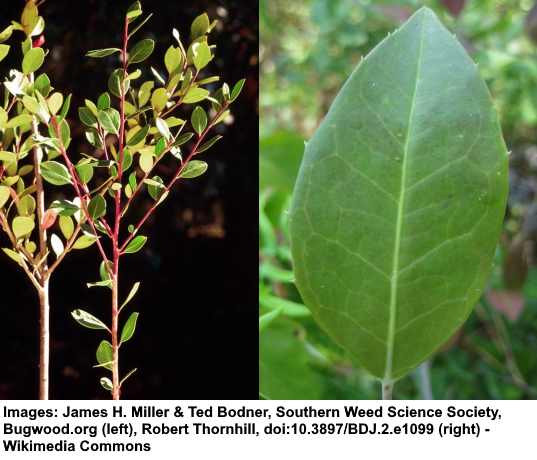
Tall Inkberry holly (Ilex coriacea)
The tall inkberry holly tree is an evergreen holly plant with elliptical oblong leaves, serrated margins, and dark red or black globose berries. The small flowering evergreen tree grows well as a hedge or specimen plant in a garden landscape.
Sun exposure: Full sun or partial shade
Size: 20 ft. (6 m)
USDA zones: 6 to 9
Holly tree leaves: Prickly, leathery, shiny dark green leaves that are 3” (7.5 cm) long and an ovate to oval shape.
Holly tree berries: Small shiny black oblong fruits.
Nellie Stevens Holly Tree (Ilex ‘Nellie Stevens’)
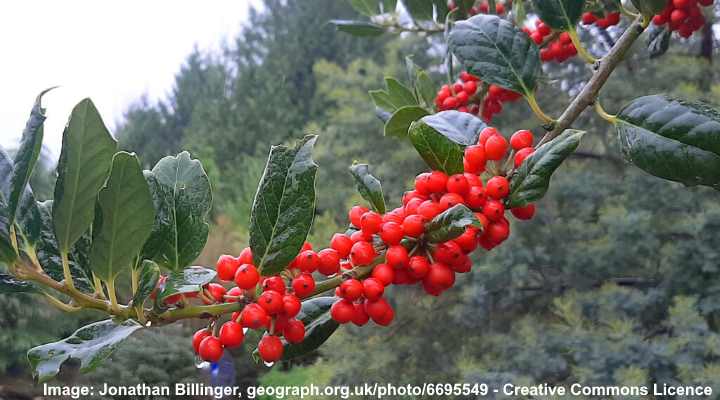
Nellie Stevens holly (Ilex ‘Nellie Stevens’)
The Nellie Stevens holly tree has a conical shape of dense, dark green, glossy foliage, bright red berries, and white spring flowers. The Nellie Stevens is a popular landscaping shrub-like tree for its shiny appearance and ease of care. Grow as an evergreen screen to keep out unwanted intruders or wildlife.
Sun exposure: Full sun or partial shade
Size: 20 to 30 ft. (6 – 10 m) tall and up to 15 ft. (15 m) wide
USDA zones: 6 to 9
Holly tree leaves: Dark green, waxy leaves that are 2.5” (6.5 cm) long with five to six spines on each side.
Holly tree berries: Clusters of red berries in the winter.
Types of Holly Bushes (With Pictures)
Winterberry Holly (Ilex verticillata)

Winterberry holly (Ilex verticillata)
The winterberry holly is a large deciduous shrub with dark green, tooth-edged leaves, greenish-white flowers, and showy, bright red berries. The abundance of red berries in winter gives this rounded bush an attractive appearance despite not having leaves. Plant this holly species as a hedge, foundation planting, or border shrub.
Sun exposure: Full sun to partial shade
Size: 3 to 15 ft. (1 – 4.5 m) tall and 3 to 12 ft. (1 – 3.6 m) wide
USDA zones: 3 to 9
Holly bush leaves: Dark green obovate-shaped leaves with toothed margins measuring 2” to 3” (5 – 7.5 cm) long.
Holly bush berries: An abundance of showy scarlet red berries that look stunning throughout winter on bare branches.
Inkberry Holly Bush (Ilex glabra)
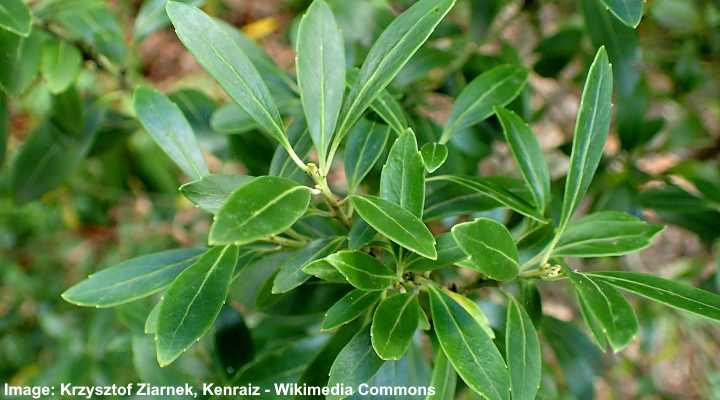
Inkberry holly bush (Ilex glabra)
The inkberry holly shrub has leathery obovate leaves, inconspicuous yellow flowers, and jet-black berries growing abundantly among evergreen foliage. Also called the gallberry bush, inkberry bushes have a broadly rounded shape and don’t grow too tall. As an alternative to boxwood shrubs, inkberry shrubs are ideal low-growing hedging plants.
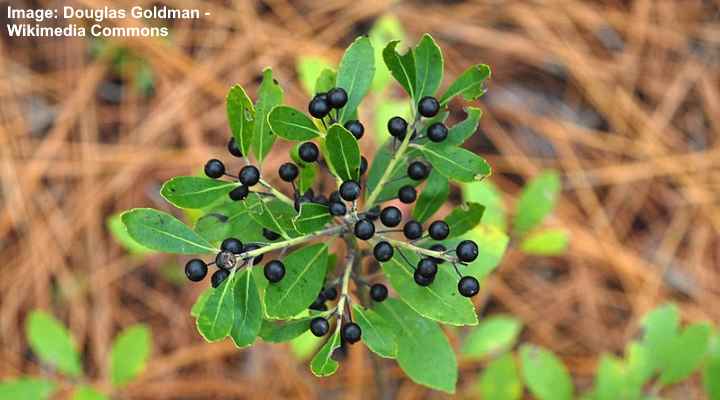
Ilex glabra berries
Several dwarf inkberry holly bush cultivars include ‘Strongbox,’ ‘Compacta,’ ‘Shamrock,’ and ‘Gem Box.’
Sun exposure: Full sun to part shade
Size: 5 to 8 ft. (1.5 – 2.4 m) tall and wide
USDA zones: 4 to 9
Holly bush leaves: Inkberry holly bush leaves are 1.5” (3.8 cm) long, ovate to elliptic shape, with a dark green glossy shine.
Holly bush berries: Inkberry holly bush berries are black, pea-sized drupes that grow abundantly on branches.
Blue Holly (Ilex × meserveae)
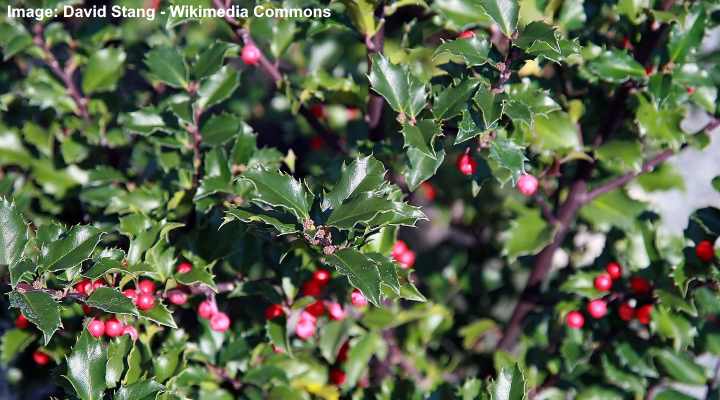
Ilex meserveae ‘Blue Princess’
Blue holly is a large shrub or small tree with glossy green, pointed leaves with spines on the margins and shiny crimson red berries. Several blue holly cultivars have beautiful bluish-green shiny foliage. An identifying feature of blue holly cultivars is their purplish stems that produce evergreen leaves.
Sun exposure: Full sun to part shade
Size: 3 to 6 ft. (1 – 1.8 m) tall and 8 to 15 ft. (2.4 – 4.5 m) wide, depending on the cultivar
USDA zones: 3 to 7
Holly bush leaves: Blue holly leaves are dark green to blue, measure 1” to 2.5” (2.5 – 6 cm) long, and have four to eight spines on each margin.
Holly bush berries: Blue holly berries are round red berries that are on the bush throughout winter.
Longstalk Holly (Ilex pedunculosa)
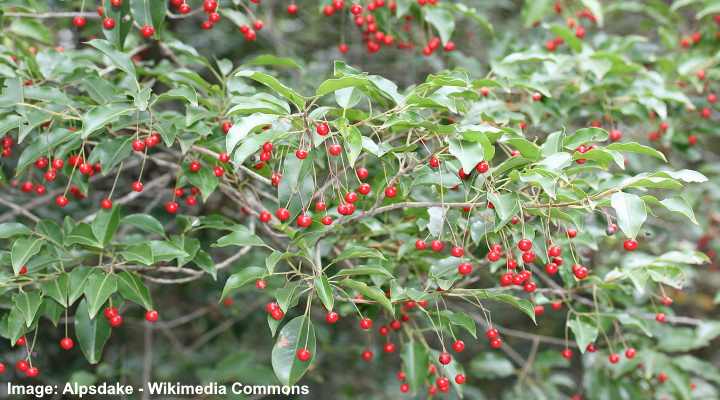
Longstalk holly (Ilex pedunculosa)
The longstalk holly bush is a broadleaved evergreen plant with glossy green smooth leaves without any serration or spines on the edges. The distinguishable feature of this holly is its long, drooping leafy stalks. In addition, the long pendulous stalks feature clusters of red berries throughout winter.
Sun exposure: Full sun to partial shade
Size: 10 to 20 ft. (3 – 6 m) tall with a spread of 10 to 15 ft. (3 – 4.5 m)
USDA zones: 5 to 8
Holly bush leaves: Longstalk holly leaves have smooth margins, a glossy green shine, and measure 1” to 3” (2.5 – 7.5 cm) long.
Holly bush berries: An abundance of red berries grow on pendulous stems.
Related articles:
